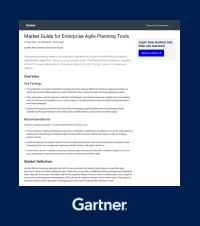Benefits of a PPM tool for the Project Management Office

More and more organizations are opting for PPM software to support their project portfolio management processes. It is not a secret that integrating a PPM tool with existing decision-making processes on issues such as prioritization of initiatives or resource management brings positive results for companies. But what about the PMO? What are the benefits of a PPM tool for the Project Management Office?
Advantages of a Project Portfolio Management software
Most organizations and technology leaders agree that even a modest investment in a project portfolio management solution can yield noticeable benefits – even significant returns in some cases of higher dollar applications across the enterprise. Commonly conceived benefits of a Project Portfolio Management solution implementation include:
- Prioritization for decision-making.
- Faster project executions.
- More accurate and planning and forecasting of investments in projects for the organization.
- More optimized resource utilization.
As we consider in this post the key benefits a PPM solution can bring to the project office roles in the organization, let’s first consider what a PPM is and what it does for the organizations that interact with it.
See the Triskell platform in action in a personal demo
What is Project Portfolio Management?
“Project Portfolio Management (PPM) is the centralized management of the processes, methods, and technologies used by project managers and project management offices (PMOs) to analyze and collectively manage current or proposed projects based on numerous key characteristics.”
When making the case for a PPM solution, the key is to demonstrate how the project portfolio management software and processes will make a positive impact on the organizational roles in the organization. One key role player in that scenario is the project management office (PMO) for many larger and more established organizations and project management infrastructures.
The key is to demonstrate how PPM processes will make a positive impact
As we examine the PPM benefits for the project management offices, let’s first look at how the PMO leadership would benefit. That usually means the PMO director, leader or some senior project manager generally charged with overseeing this unit.
PMO leadership benefits
What are the standard goals of a PMO? Consider… whether the PMO is led by a manager, director, or a senior member of the project management organization, the desired results likely include:
- Project & resource prioritization; supporting the work demand.
- Increasing organizational agility.
- Accurate planning & forecasting.
- Elevating value perception of PMO through communication & collaboration.
Effective prioritization processes of incoming demand
Achieving these goals begins with effective prioritization of incoming work demand. Demand for new IT projects at the present remains high, with a majority of organizations planning for an increased demand for new tech projects over the next two to three years. Project offices and companies can’t say yes to every project that comes their way – most organizations are citing a shortage of technical resources to staff IT projects.
Another consideration is this – not all requests are worth investing in. It is equally important for the PMO to justify saying “no” to a low value and no value work – ensuring the PMO is making the right business decisions to achieve organizational goals and not just wasting company money running down projects that offer little to no ROI.
PMOs must make the right business decisions to achieve organizational goals
PMOs that accept all incoming work demand will struggle to meet their commitments due to their inability to prioritize or accurately forecast what can or cannot be completed on time and on budget. The problem keeps getting worse because requests continue to flow, and if the projects are not re-prioritized, the organization runs the risk of investing in low priority work before higher priority work that is just sitting in the backlog of projects somewhere.
The existence of this frustrating cycle is exactly why management continuously calls the existence of the PMO into question. PMOs must have the proper scoring and ranking capabilities to facilitate valuable conversations with key stakeholders to enable better decision-making – specifically around prioritizing projects and resources. Without these capabilities, PMOs will continue to be perceived simply as a project oversight and management function and not as drivers of real business value.
Scalability and agility to adapt to change
Decisions will be made based on the information currently available to the organization, but when the environment changes, the PMO should strive to have organizational scalability and agility. Adapting to changes is critical as nothing in today’s business world is static – priorities change, resources move (or get moved), and business needs evolve to stay competitive. PMOs should constantly look for ways to increase the accuracy of their estimates and forecasts.
Their forecasts are commitments to the organization for delivering key initiatives. Organizations with portfolio management have a much higher strategic adaptability – ensuring they are more likely to be aligned with business objectives than those without portfolio management. Maintaining business alignment directly impacts ROI of strategic investments. This is why it is not surprising that organizations with portfolio management report higher ROI from strategic initiatives. This is significant because we know the lack of perceived value is the top reason why the existence of the PMO is called into question.
Organizations with portfolio management have a much higher strategic adaptability
While it may seem challenging for organizations to achieve all of their PMO’s objectives, implementing a PPM solution will increase the chances of success. Whether the PMO needs to improve prioritization, increase agility, or simply communicate the business value of their efforts, portfolio management empowers PMOs to make better decisions, stay aligned with the business and most importantly maintain accurate forecasts.
Benefits to project managers
The value of portfolio management to CIOs, IT executives, and PMO management is quite clear as a decision making, prioritization and resource management tool, but many times the real internal challenge is getting buy off from the end-users – the project managers and project team members in the organization and PM infrastructure. We must also consider what value the PPM brings to this important group as we push for full engagement of such a tool across the enterprise to maximize the ROI. Just like the other areas of the organization, the specific goals of these individuals should be accounted for:
- Project success with on-time & on-budget delivery.
- Meet desired outcomes of projects.
- Proactive communication & reporting.
- Justify resource requests.
Project delivery on time and budget vs Project outcomes
Many times this level in the organization may not have exposure to the prioritization and alignment of projects and resources to business goals – they are focused solely on project delivery. In many organizations, project managers are simply just handed a project with a set of resources and expected to execute under whatever circumstances present themselves; even when resources get pulled or assigned to more projects, the project must somehow reach completion.
More advanced organizations focus on project outcomes over project outputs
More advanced organizations are thinking about project outcomes over project outputs, focusing on the impact of the executed work over execution. But commonly project success is measured by on-time and on-budget delivery. However, even with this focus, the industry-wide success rate of projects is only a little over 50% – which shows then a definite area for project success improvement.
Justified resource requests
The primary reason for project failure is usually poor resourcing of some kind. This includes:
- Inadequate staffing
- Overallocation
- Mismatched skillsets for the assigned project or task
Requesting additional resources or reallocation of team members is challenging if a project manager does not have data to justify the change and can be costly to the project in terms of budget and timeframe. Hitting the mark from the beginning on resources, utilization and allocation using a good tool such as a PPM is far more desirable – so that those types of resource issues are far less likely to be realized. Without this better insight for resource planning and utilization, the result is the organizational expectation that the team should execute and deliver no matter what – and often under less than optimal circumstances.
See the Triskell platform in action in a personal demo
Proactive communication & reporting
Similarly, another critical expectation from this group is accurate communication and reporting of projects. This may include project health, risks, schedule updates, or some other key performance and project progress or status indicators agreed upon by the organization.
Most business executives would agree that project management teams should report on project status as one of their primary objectives. That’s no big surprise, as stakeholders and project managers agree reporting is always a critical focus for the role. However, many executives and organizational leaders cite overall status reporting as a project management weakness in the organization – and this is definitely an area where a solid PPM solution can fill a needed gap.
Conclusion
A PPM solution will close gaps and help drive improved project success. Organizations that develop high maturity of portfolio management will likely see a majority of their projects completed on-time, as compared to less than half of those organizations with low portfolio management maturity. Results are going to be very similar for projects staying and completing on – or close to on – budget.
A PPM solution will close gaps and help drive improved project success
What does it take to become high maturity in terms of PPM? Not much. Just starting to take advantage of a solid PPM solution and such benefits as reporting, dashboards, resource capacity and demand, and prioritization can make a huge impact for most organizations, especially those who right now rely on spreadsheets for portfolio management capabilities. The ultimate result for organizations with PPM is increased project success rates – which is always one of the primary goals for project managers and business leaders.
Subscribe to our Newsletter
Get stories like this in your inbox
Request a demo of Triskell Software
Would you like to know how Triskell Software can help you with resource management in your organization while applying the Phase-Gate methodology?

FAQs about benefits of PPM
What are the key benefits of using a PPM tool?
Project Portfolio Management (PPM) tools offer a variety of advantages, including:
- Improved prioritization for decision-making: By providing a centralized view of all projects, PPM tools help organizations prioritize initiatives based on strategic alignment and potential ROI.
- Faster project execution: Streamlined workflows and collaboration features within PPM tools can significantly accelerate project completion times.
- Optimized resource utilization: These tools help identify and avoid resource conflicts, ensuring team members are assigned tasks effectively.
- Enhanced planning and forecasting: PPM tools enable more accurate forecasting of project timelines, resource allocation, and budgets.
How can PPM tools improve project success rates?
PPM tools contribute to project success in several ways:
- Reduced risk: By facilitating proactive identification and mitigation of potential problems, PPM tools help projects stay on track.
- Improved communication and collaboration: Centralized communication and document sharing within a PPM tool ensure everyone involved in the project has access to the latest information.
- Better resource management: Effective resource allocation through PPM tools prevents overallocation and ensures projects have the necessary skills and expertise to succeed.
Is a PPM tool right for my organization?
PPM tools offer significant benefits for organizations of all sizes, particularly those that manage multiple projects or complex portfolios. Here are some indicators that a PPM tool could be valuable:
- Difficulty in prioritizing projects due to limited visibility.
- Frequent project delays or missed deadlines.
- Inconsistent or inaccurate project budgeting and forecasting.
- Inefficient resource allocation leading to underutilized or overworked team members.
What are some of the challenges associated with implementing a PPM tool?
While the benefits of PPM tools are clear, there are also some challenges to consider:
- Change management: Transitioning to a new project management system may require user training and addressing resistance to change.
- Data migration: Migrating existing project data into a new PPM tool can be a complex process.
- Integration with existing systems: Ensuring compatibility between the PPM tool and other software used by the organization is crucial.
Related Content

Why the CIO needs a PMO approach
Unlock business success: discover why the CIO must embrace a PMO approach! to elevate efficiency and boost productivity.

Lean Budgeting for Agile Portfolios: A Comprehensive Guide
Lean Budgeting: the financial revolution for Agile portfolios. Discover how to streamline project financing and optimize value delivery.

Implementing SAFe with a 7-step roadmap
Do you want to scale Agile at the enterprise level and don’t know where to start? We solve your doubts by explaining the steps to implement SAFe.

